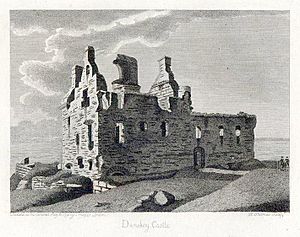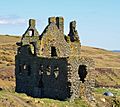Dunskey Castle facts for kids
Dunskey Castle is an old, ruined castle from the 12th century. It's located about half a mile (0.8 km) south of Portpatrick village in Scotland. This castle is a special scheduled monument. This means it's a very important historical site. It is protected so no one can change it without permission.
Dunskey Castle is also famous for being a filming location. It was used in the 1951 movie "Kidnapped" and the 1952 film Hunted.
Contents
What Does It Look Like?
The castle has three floors and is shaped like an "L". It sits on a piece of land that sticks out into the sea. To protect it, there's a wide ditch, about 15 meters (49 feet) across, at the only entrance. The castle itself is about 30 meters (98 feet) long and 14.3 meters (47 feet) wide. Its walls are very thick, about 1.5 meters (5 feet) wide.
Today, the castle is a roofless shell, meaning it has no roof. You can still see the foundations of other parts that were once there. Close by, there are also remains of a watchtower. Old maps from the 1580s show Dunskey Castle with two watchtowers by the sea.
A Look Back in Time: Early Years
People believe the area around Portpatrick, where Dunskey Castle is, has a very long history. Some stories say it goes back to the first century AD! Portpatrick was known as the main port for Dunskey Castle.
In the late 1200s, a powerful Scottish noble named John Comyn might have helped build Dunskey Castle. Around this time, Edward I of England was in charge of nearby Wigtown Castle. He later gave Wigtown Castle to John Balliol, who was the Scottish King.
After John Balliol, Robert the Bruce became King of Scotland. During his time, around 1326, some lands in the area, including those connected to Dunskey Castle, were given to a family called Adair.
Changes Over the Centuries
The Adair family became very important owners of Dunskey Castle. In the 1400s, there were some changes in who owned the castle. At one point, Gilbert Kennedy, 1st Lord Kennedy had control of the lands around Dunskey. But eventually, the Adair family got it back.
Around 1488, the Adair family faced attacks. William Adair of Dunskey Castle was attacked by a sheriff and his men. The castle was even partly burned around 1489 by another group, the Clan McCulloch.
After being damaged, Dunskey Castle was repaired in the early 1500s by the Adairs. They rebuilt the main hall, making it much bigger. The Adairs also built another castle nearby, the Castle of St. John in Stranraer, around 1510.
Ninian Adair, who took over the castle after his father died in battle, made even more improvements. He made the castle grander and tried to end old family fights by marrying a woman from a rival family. There are old stories of a secret cave under the castle and even a piper ghost!
Later Years and Ruin
In the early 1600s, the Adair family still owned Dunskey Castle. But later, in 1620, a man named Hugh Montgomery, 1st Viscount Montgomery bought the castle. He added new parts, like a "Gallery" leading from the main hall. His wife even wrote a letter about how expensive the building work was!
However, the Montgomery family faced financial problems. Because of this, Dunskey Castle eventually passed to the Blair family. By 1684, Dunskey Castle was already a ruin. This was only about 50 years after Viscount Montgomery had added his new gallery.
Today, the castle is still a beautiful ruin. The current owner, Lady Amy McFall, limits public access to the castle.
Images for kids



